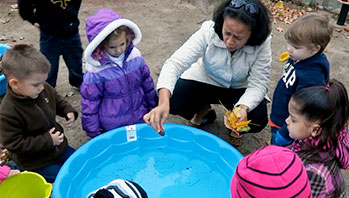- boxes and other objects (ramp bases)
- camera or cell phone with camera
- cardboard sheets or wooden planks (incline planes)
- drawing materials
- objects that roll, slide, or stay put on a slide (balls, blocks, erasers, pompoms, rolls tape, toy cars, etc.)
- move
- ramp
- roll
- shape
- slide
- stay put
- texture
- weight
MA Standards:
Language/L.PK.MA.6: Use words and phrases acquired through conversations, listening to books read aloud, activities, and play.
MA Draft STE Standards:
Physical Sciences/Motion and Stability; Forces and Interaction/PS2.A: Plan and carry out investigations of the behaviors of moving things.
Physical Sciences/Motion and Stability; Forces and Interaction /PS2.B: Using evidence, discuss ideas about what is making something move the way it does and how some movements can be controlled. [Cause and Effect, Stability and Change]
Head Start Outcomes:
Logic and Reasoning/Reasoning and Problem Solving: Recognizes cause and effect relationships.
Science Knowledge/Scientific Skills and Method: Uses senses and tools, including technology, to gather information, investigate materials, and observe processes and relationships.
PreK Learning Guidelines:
English Language Arts/Language 2: Participate actively in discussions, listen to the ideas of others, and ask and answer relevant questions.
Science and Technology/Physical Sciences 19: Explore, describe, and compare the properties of liquids and solids found in children's daily environment.
Science and Technology/Physical Sciences 21: Explore and describe various actions that can change an object’s motion such as pulling, pushing, twisting, rolling, and throwing.
Explore Together (outdoors): Roll, Slide, or Stay Put?

© Commonwealth of Massachusetts, Department of Early Education and Care. All rights reserved.
STEM Key Concepts: A ramp, or inclined plane, is a surface with one end higher than the other; An object placed on an inclined plane will roll, slide, or stay put; The shape of an object affects whether it will roll or slide or stay put
ELA Focus Skills: Speaking and Listening, Vocabulary
Educator Prep: Set up various ramps outside for children to use in their explorations.
Safety Tips: Before taking children outside:
- Check areas for poison ivy, poison sumac, nettles and bushes with thorns before taking children outside.
- Remind children to wash their hands before and after the activity.
Take children outside to the playground slide or ramp (or ramp you set up.) Explain to children that the slide is a type of ramp. Tell children that they will continue to explore things that stay put, roll, and slide down a ramp.
Introduce the materials by displaying an object that will stay put, such as a rubber eraser.
- Place the eraser on the ramp.
- Ask children why they think the object stays put on the ramp and doesn't move down the ramp.
Discuss how the shape, texture, or weight of an object can affect the way it moves, or doesn’t move, down the ramp. Place a smooth ball and a fuzzy eraser on the ramp to reinforce this concept.
Let children freely explore the ramps and other materials, paying attention to how each object rolls, slides, stays put, or rolls and slides. Help children to take pictures or videos of each other's explorations.
- Encourage children to make predictions before sending objects down the ramp.
- Prompt children to share their observations with others as they explore.
Watch and engage children when you notice something that sparks their curiosity. For example, a child may discover that an object will roll if placed sideways on the ramp, but slide if placed pointing down. If a child does not spontaneously make this discovery, you may want to pose questions such as,
- Can you figure out a way to make the pencil slide down the ramp instead of roll? Can you make it stay put?
- I noticed how the pompom stayed put when you put it on the <cardboard> ramp. What do you think would happen if you sent it down the slide?
Reflect and Share
Once inside, invite children to share their predictions and observations. View pictures and/or videos to help children recall observations. Focus the discussion on how the shape or texture of an object can cause it to stay put. Ask questions such as,
- Why do you think the smooth block slid down faster than the rough box?
- What did you do to make the rubber eraser slide down the ramp?
Social Emotional Tip: Asking children to predict helps build their ability to recognize and express their own thoughts, ideas, and opinions.
